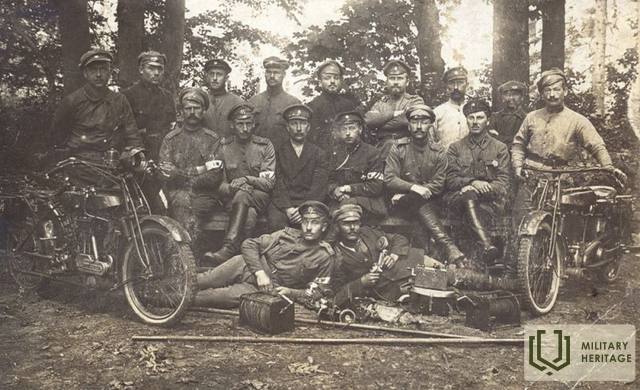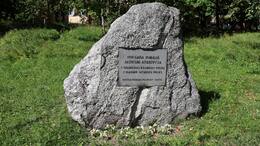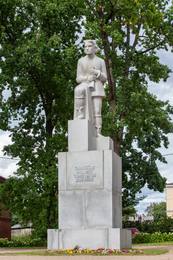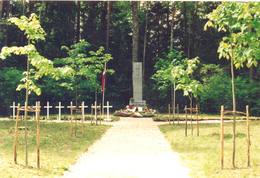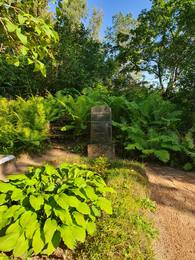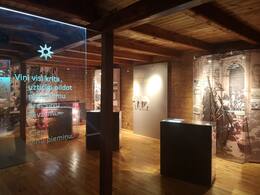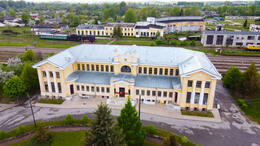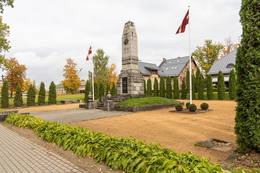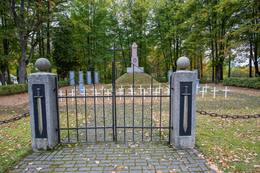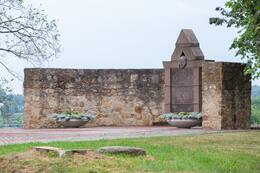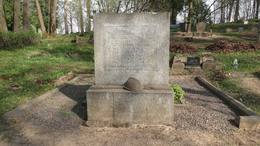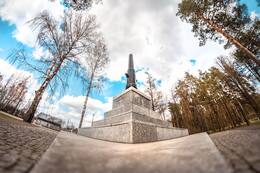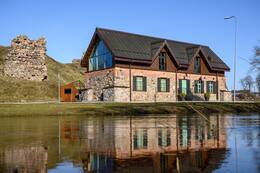1st (4th) Valmiera Infantry Regiment
I Wars of Independence
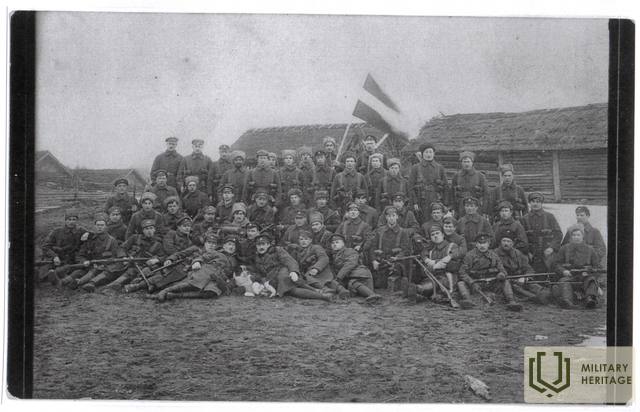
On the basis of the agreement concluded by the representatives of the Latvian and Estonian governments in Tallinn (Rēvele) on February 18, 1919, the Commander-in-Chief of the Estonian Army, Major General Johan Laidoner, authorized the formation of one infantry battalion and one artillery platoon. The place of formation was determined to be Tartu (Tērbatu), where Lieutenant Colonel Jūlijs Jansons began the formation of Latvian troops on February 18. Mobilizations of Latvian citizens were announced in the northern part of Latvia liberated from the Bolsheviks and in Estonia, which allowed the formation of a regiment, which was named the 1st (Latvian) Valmiera Infantry Regiment, in a short time.
The regiment formed on March 27 (800 bayonets, 5 machine guns, 8 self-propelled guns) was sent to the Alūksne front of the Estonian army and the Latvian Bolshevik army, Ape district, where after an unsuccessful first battle it was forced to retreat to its starting positions on the right bank of the Melnupe to defend against the attempts of the 4th Latvian Riflemen Soviet Regiment to cross the river. As the Bolsheviks retreated, the regiment occupied Api (27.05.), Vecgulbene (31.05.), Lubāns, and by June 5 reached Krustpils and Jēkabpils. The regiment's front stretched from Kaldabruņa on the right bank of the Daugava to Balvi. The 3rd battalion, an engineer company, was formed during the mass mobilization. The regiment's artillery battery participated in the battles of Cēsis. After the Battle of Cēsis, the regiment was included in the Vidzeme Division of the Latvian Army and renamed the 4th Valmiera Infantry Regiment.
At the end of the summer, the regiment occupied the front line Līvāni-Atašiene-Barkava, being in constant combat action against the Bolshevik Red Army, but at the end of September it was redeployed to Riga. From October 1919, the 4th Valmiera Infantry Regiment, under the command of Lieutenant Colonel Kārlis Bojārs, participated in the defeat of Bermont's troops. After that, it continued fighting against the Bolsheviks in Latgale until the end of the War of Independence. 70 soldiers of the regiment fell in the Latvian War of Independence. 178 soldiers of the regiment were awarded the Lāčplēsis War Order.
After the Latvian War of Independence in October 1920, the 4th Valmiera Infantry Regiment was transferred to Riga, where it existed as part of the Vidzeme Infantry Division until the occupation of Latvia in 1940, when it was incorporated into the People's Army.
More information sources
History of the Valmiera Infantry Regiment. 1919-1929. Riga, 1929. – 465 pages, partly included in the collection of articles: Ziemeļnieki II., 1974. http://www.periodika.lv/periodika2-viewer/view/index-dev.html#panel:pp|issue:/g_001_0306121295|article:DIVL118|issueType:undefined
Valmiera Infantry Regiment. Artas Bukas Encyclopedic Dictionary of History. https://vesture.eu/Valmieras_k%C4%81jnieku_pulks
Related objects
Memorial stone to the liberators of Alūksne
Located in Alūksne, at the intersection of Helēnas and Alsviķu streets.
The memorial stone was unveiled on May 29, 1999, on the 80th anniversary of the liberation of Alūksne. The stone carving work was carried out by sculptor Ainārs Zelčs.
On March 31, 1919, the Northern Latvian Brigade was founded in the city of Tartu, with the task of liberating Vidzeme and Latgale. The brigade consisted of the combined 1st Valmiera and 2nd Cēsis Infantry Regiments, later also the Northern Latvian Partisan Regiment, two cavalry squadrons and two artillery batteries. On May 26, these forces occupied Valmiera, but on May 27, the 1st Valmiera Infantry Regiment, together with the 2nd Estonian Cavalry Regiment, launched an attack in the direction of Alūksne. The Bolsheviks were unable to repel further attacks, and on May 29, 1919, Alūksne was liberated.
Monument “Tālavas taurētājs”
Located in Rūjiena Center Square.
The three-meter-high image of an ancient Latvian guard soldier, carved from gray Finnish granite, called the “Tālavas trumpeter”, is placed on a three-meter-high granite pedestal, but the total height of the monument reaches 7.5 meters. In the initial sketches and models, K. Zemdega had placed a sword in the warrior’s hands, which was later replaced with a trumpet. The monument was unveiled on August 15, 1937.
This monument reflects the difficult situation in the formation of our state and army, as well as the assessment of these events. Immediately after the proclamation of the Latvian state, the Red Army invasion began and the provisional government of Kārlis Ulmanis found refuge in Liepāja. In February 1919, with the help of the Estonian army, the liberation of Latvia from the north began and the first mobilizations of the Latvian troops being formed in Tērbatas took place in the Rūjiena area, which, under the command of Colonel Jorģis Zemitāns, became the North Latvian Brigade. The North Latvian Brigade fought not only against the Bolsheviks, but also against the Landeswehr and the Iron Division in the battles of Cēsis. The North Latvian soldiers mobilized in the Rūjiena area also fought in subsequent battles of the War of Independence. After the war, the main laurels of victory went to General Jānis Balodis and the South Latvian Brigade commanded by him, but the North Latvian Brigade was often forgotten. The planned monument to the North Latvian Brigade in Rūjiena also took a long time to be created, and the monument, unveiled in 1937, was officially promoted as a monument to the liberation of the Rūjiena region and in memory of the fallen soldiers, without mentioning that all the regiments that were part of the North Latvian Brigade had their beginnings in Rūjiena.
The monument is not only a popular tourist attraction for Latvian and Estonian tourists, which is to some extent a starting point for visiting several other War of Independence memorial sites in Rūjiena, but the "Tālavas tauretājs" is also a stopping point for visits by Estonian and Latvian state and local government officials of various levels.
The Rūjiena Liberation and Fallen Soldiers Monument, more commonly known as the "Tālavas tauretājs" (Far-away Horner), was included in the list of state-protected cultural monuments on October 29, 1998 as an art monument of national importance (monument protection registration number 4522).
Karva Brothers Cemetery
Located on the side of the Alūksne - Ape road near Zuši mājas, south of Karva, at the turnoff to Rezakas.
The monument was unveiled on September 12, 1937. The granite stele was made at the O. Dambekalns stone quarry in Riga, after a design by the War Construction Administration architect Vemers Vitands.
In the autumn of 1975, local communists destroyed the monument. On March 30, 1989, the Alūksne District Council made a decision to restore the monument, and on April 30, 1989, a temporary wooden memorial in the form of a Latvian grave marker was installed in its place, made by Jānis Jaunzems, a worker at the State Electrical Factory (VEF). The inscription on it read: “The Karva Brothers Cemetery Monument will be restored here.”
At that time, the nearby Brothers' Cemetery was also improved.
In 1993, thanks to the initiative of Ulda Veldre, head of the Alūksne Brothers' Cemetery Committee, the restoration work of the memorial site resumed. The new monument was made by the Cēsis stonemason brothers Aivars, Austris and Auseklis Kerliņi.
The monument was unveiled on June 11, 1994.
Four soldiers of the 5th company of the Valmiera Infantry Regiment are buried in the fraternal cemetery - Jēkabs Sukse, Pēteris Leitlands, Ernests Puķītis and Gustavs Ozols, who fell in the battles near Zuši on April 2, 1919. The fifth soldier buried in the mid-1930s was Roberts Glazners, a soldier of the Valmiera Regiment who disappeared without a trace on March 31, 1919 near Jaunā muiža. Initially, he was buried as an unknown, but later his name was clarified and engraved on a monument. In turn, the fifth soldier who fell in the Battle of Zuši, Augusts Dzedons (Ziedons), is buried in the Apekalna cemetery.
A memorial plaque has been installed at the foot of the monument to Jānis Goldes (1891–1952), a participant in the Battle of Eels, who died in the communist concentration camp in Inta, Komi.
The second memorial plaque, unveiled on August 23, 1992, is installed near one of the wooden crosses and is dedicated to Corporal Pēteris Jansons of the 7th Sigulda Infantry Regiment, who was murdered by the departing communists on July 7, 1941.
Gulbene City Old Cemetery Jāņkalniņš
Located in the Old Cemetery of Gulbene on Miera Street.
In 1934, a memorial stone was unveiled at the Gulbene Old Cemetery in Jāņkalniņas to the fallen soldiers of the 1st (4th) Valmiera Infantry Regiment.
Monument and burial place to the soldiers of the 1st (4th) Valmiera Infantry Regiment, who fell in May 1919, liberating Vecgulbene from the Bolsheviks - in the Old Cemetery in Jāņkalniņa. In 1934, with the care of the Gulbene defenders, a monument was erected, which miraculously (possibly due to the fact that it was deeply embedded in bushes and weeds) remained undamaged throughout the Soviet era.
Cultural Heritage Centre "Tīnūži Manor"
The Cultural Heritage Centre ‘Tīnūži Manor’ is located in Ogre municipality, Tīnūži village, 7 km from the cities of Ogre and Ikšķile. The first written evidence about the manor dates back to the 16th century. Until the mid-18th century it was considered an economic production unit with small and insignificant buildings. But over time it grew into a large farm. During World War I, battles between the Russian and German armies took place here, and the Latvian Riflemen were also involved. During the War of Independence Tīnūži manor was used as the headquarters and armoured car park of the 1st Valmiera Infantry Regiment of the Latvian Army. In 1932, the manor was given to the Union of the Latvian War Invalids, which provided accommodation and care for war veterans. During World War II (in 1943) the German Army unit FAT 212 was transferred from Estonia to Tīnūži manor. It was a saboteur unit that prepared soldiers to fight the Red Army. Latvian soldiers were also trained in the arts of intelligence gathering, guerrilla warfare tactics and sabotage. The lord house of Tīnūži manor was destroyed when the Red Army was moving towards Riga. Nowadays it is a place with a beautiful landscape and historical buildings on the banks of the Little Jugla River. Exhibits dedicated to historical events, including the ones concerning the Latvian Riflemen, can be seen at the Cultural Heritage Centre ‘Tīnūži manor’.
Gulbene Railway Station
The Gulbene Railway Station is located in the city of Gulbene. During World War I, in 1916 to 1917, the narrow-gauge railway line to Pļaviņas was reconstructed to 1,524 mm width to ensure that it can serve as a connection to the Rīga-Daugavpils line. In addition, a railway line to Ieriķi and to Sita was constructed, thereby establishing a connection with Pytalovo. As a result, Gulbene became a railway hub. The current station building by architect Pēteris Feders was constructed in 1926. During the War of Independence, on 31 May 1919, when Gulbene was liberated from the Bolsheviks, the 1st (4th) Valmiera Infantry Regiment collected a significant number of war trophies here. On 14 June 1941, both civilians and Latvian Army officers arrested in the Litene Summer Camp were deported from the Gulbene Railway Station. As a key hub, it was bombed in the spring of 1944. After the war, it was restored to its original form. An educational and interactive centre named ‘Railway and Steam’ was opened in 2018. Next to the Gulbene station is the company SIA Gulbenes – Alūksnes bānītis, which offers interactive lessons and tours. Visitors have access to the station building and platform, a memorial plaque and a monument to the repressed ones by sculptor Indulis Ranka.
Monument to the fallen heroes of Gulbene parish for the freedom of Latvia
Located in the historical center of Gulbene, opposite the Gulbene Evangelical Lutheran Church.
Monument to the victims of the 1905 riots, the members of the Gulbene congregation who fell in World War I and the Latvian War of Independence, and the victims of the Maliena Tribunal. The monument was designed by E. Ābeltīns and was unveiled in 1929 opposite the Gulbene Evangelical Lutheran Church. After World War II, a five-pointed star was placed on the monument, then - on its base - a plaster image of a Soviet soldier painted in bronze, and a cemetery for fallen Soviet soldiers was established behind the monument. When in 1969 the new cemetery for Soviet soldiers who fell in World War II was opened in Spārīte Park, the remains of the fallen were transferred there, but the site of the monument was leveled with the ground. In the autumn of 1989, the foundations of the monument were excavated and the capsule with the text, which had been walled in them in 1928, was brought out. The monument was restored in 1992 (sculptor O. Feldbergs).
Between December 24, 1918 and May 31, 1919, when the 1st (4th) Valmiera Infantry Regiment liberated Gulbene from the Bolsheviks, the church housed the Maliena (Vecgulbene) Revolutionary Military Tribunal and Workers' Club. Its activities were notable for the severity of its decisions and the large number of death sentences, often for minor offenses - 349 cases were investigated, in which 606 persons were accused.
A memorial sculpture is visible.
Monument to the soldiers who fell in the War of Independence
Located in Valka on Varoņu Street next to the Forest Cemetery.
A monument to 30 soldiers of the 1st (4th) Valmiera Infantry Regiment who fell in the Latvian War of Independence can be seen.
The monument was unveiled on October 1, 1922. It consists of a figure of an ancient Latvian warrior (“Ancestor”) carved from local reddish granite, placed on a two-part pedestal made of gray granite. The design chosen for the monument was by sculptor Emīls Melders (Miller). Along with Melders, sculptor Vilhelms Treijs also participated in the carving of the monument.
It is the first monument to the Latvian War of Independence created by a professional sculptor, as well as the only one in the interwar period made in the modernist style, using cubist elements.
During the repeated communist occupation in 1951, the monument sculpture was toppled, partially damaged, and buried. The burial grounds were also leveled.
In 1988, as the centenary of the sculptor E. Melders (1889-1979) approached, a study of his works was initiated.
The restored fraternal cemetery, along with the restored monument, was opened on November 11, 1990.
In 2017, eight memorial steles were installed at the fraternal cemetery to the knights of the Lāčplēsis War Order associated with Valkas. They are located on both sides of the monument – four steles on each side.
Monument to those who fell for the Fatherland in 1918-1920.
Located on the side of Rīgas Street, opposite Krustpils Castle.
In Jēkabpils, on the right bank of the Daugava River, the monument “To Those Who Fell for the Fatherland 1918–1920” was erected, a proposal to erect a monument to soldiers who fell in the War of Independence was made by the Krustpils branch of the Latvian Brothers’ Cemetery Committee on June 12, 1923. For the creation of the monument, the Krustpils parish board transferred to the Brothers’ Cemetery Committee on November 12, 1923 a stone part of the monument to Tsar Alexander II near the parish board building, where the monument had been erected in honor of the abolition of serfdom. The Latvian Ministry of the Interior allowed the Krustpils branch of the Brothers’ Cemetery Committee to collect donations. A total of 2,400 lats were donated, 1,200 were missing. They hoped to get them from the bazaar and social evening organized on the day of the monument’s opening.
The project of the monument was entrusted to the architect Aleksandrs Birznieks. The architect's plans were to create a monument from local material - dolomite studs. The volume of the monument was formed by two concentric, massive semicircles of dolomite stud masonry, of which the outer one was lower on the Daugava side, cut into the bank and formed a terrace. In its center was a red brick fire cross. In the center of the main semicircle, as an altar, granite slabs with the text: "To those who fell for the Fatherland 1918 - 1920" and depicting a rising sun over the waves of the Daugava, and framed by Latvian signs, were built. The central part of the monument was formed by the mask of a fallen soldier, sculpted by sculptor V. Treijs. The acting commander of the Latgale Artillery Regiment, Lieutenant Colonel Jākobsons, allowed the use of a square on the right bank of the Daugava opposite Krustpils Castle for the construction of the monument, with the condition that the square remain the property of the Latgale Artillery Regiment.
In 1925, the Krustpils branch of the Latvian Brethren Cemetery Committee concluded an agreement with businessman V. Treija from Riga for the construction of a monument in Krustpils. On July 26, 1925, the foundation of the monument was laid. September 27, 1925 is a holy day for the people of Krustpils. The monument was unveiled with its consecration, performed by the Lutheran pastor of the Krustpils parish, K. Skujiņš. The Minister of War, R. Bangerskis, the commander of the Latgale Artillery Regiment, Colonel Kire, General K. Berķis, etc. participated. 11 cubic limestone studs, which were broken near Asote, were used for the construction of the monument.
In the 1950s, the monument “To Those Who Fell for the Fatherland 1918 – 1920” was partially destroyed – the upper part was demolished – the mask of ancient Latvian soldiers, the inscriptions were smeared, the fire cross sign was destroyed. In turn, already at the beginning of the Third Awakening, activists of the Krustpils branch of the Latvian Popular Front (LTF) included in the resolution at the first LTF district conferences a demand to restore the monument in Krustpils. Already on November 11, 1989, at the place where the monument was located, a moment of remembrance was held, in which the people of Jēkabpils commemorated their Lāčplēšis.
In early 1992, restoration work on the monument began. Granite pieces of the required size and shape are being made at the Cēsis communal enterprise plant. The granite was processed according to the drawings by E. Nīmanis and V. Treikmanis. The technical supervision of the restoration of the monument is carried out by architect Māra Steķe. In Riga, sculptor Inta Berga cast the bronze parts of the monument. All works were financed from the financing of the city of Jēkabpils. The restored monument was consecrated by the then dean of the Jēkabpils and Krustpils Evangelical Lutheran parish, Modris Plāte, and the priest of the Jēkabpils Catholic parish, Jānis Bratuškins, on November 18, 1992.
It was opened in Krustpils on September 27, 1925. The monument was designed by architect Aleksandrs Birzenieks. The inscription "For those who fell even for the Fatherland 1918-1920" is engraved on the monument. The monument was partially demolished by the Soviet occupation authorities in 1941, and completely destroyed around 1950. The monument was restored on November 18, 1992.
Monument to the soldiers of the 4th Valmiera Infantry Regiment who fell in the Latvian Liberation Wars
Located in the Kapele cemetery, on the outskirts of the northern part of Krustpils on the right side of the city of Jēkabpils, behind the Krustpils railway station on Zvaigžņu Street.
The monument is dedicated to the soldiers of the 4th Valmiera Infantry Regiment who fell in the Latvian Liberation Wars - Corporal Fridrihs Gagnus and soldiers Jēkabs Lutcs, Jānis Miķelsons, Mārtiņš Pabērzs, Jānis Statāns and Gustas Līcis, who participated in the liberation of Krustpils and Jēkabpils from the German invaders and died on August 26, 1919, and were laid to rest in a common grave on August 29, 1919.
In 1937, the Latgale Artillery Regiment turned to the Brothers' Grave Committee with a request to develop a project for the monument. The monument was designed by architect V. Vitands, while the monument in the form of a plaque was made by E. Kuraua's firm. Already on September 30, 1938, with the participation of participants in the Freedom Struggle, the Krustpils Society, and the honor guard of the Latgale Artillery Regiment, the monument was consecrated. The monument, under the text on the D side, originally had a rifle and a helmet cast in bronze. They disappeared. In 2006, the missing parts were restored in similar plastic, and on September 2 of the same year, the restored monument was consecrated with the participation of representatives of the city of Valmiera. The words are engraved on the monument: "We died so that you may live."
Livani Liberation Monument
The monument is located at the intersection of Fabrikas and Stacijas streets, where it was unveiled on June 9, 1935 by General Rūdolfs Bangerskis, honoring the memory of the soldiers who fell in the battles for the liberation of Līvāni in 1919.
Its main element is a 15-ton, vertically placed cannon barrel. In 1958, the Soviet government dismantled the symbol of freedom in Līvāni, cutting the cannon barrel into scrap metal. The residents preserved the cannonballs throughout the Soviet years, and they returned to their previous location after half a century. The idea of restoring the monument was alive among the people all these years. The Līvāni County Council, together with the residents, actively worked on the restoration of the monument. Donations were collected from the people, and on October 3, 2004, the restored Līvāni Liberation Monument was unveiled in its historical place in the city park.
Inscription on the monument: “Soldiers of the Jelgava Infantry Regiment who fell for Latvia near Līvāni and the liberation of the surrounding area in 1919. Soldiers of the former Northern Latvian Partisan Regiment.”
The names of soldiers and partisans follow.
Memorial plaques for the cavaliers of the Lāčplēsis War Order in Līvāni district have been installed nearby.
The author of the monument's design was architect Pāvils Dreimanis.
October 3–5, 1919. Battle of Līvāni
On October 3, 1919, the Bolsheviks received a strong blow on the front near Līvāni. Units of the 3rd Jelgava and 4th Valmiera Infantry Regiments, as well as units of the Latvian German Landeswehr (former Landeswehr), participated in the attack on Līvāni. With artillery support, units of the 3rd Jelgava Infantry Regiment moved across the Daugava. After the successful move, the battle for Līvāni began, which lasted all day long. At around 17:30, Līvāni station was captured, and an hour later the bridges over the Dubna River were crossed. The combined forces managed to drive the Bolsheviks out of Līvāni, and by 19:00 the city was completely liberated. On October 5, 1919, the Bolsheviks tried to regain Līvāni by attacking the new positions of the 3rd Jelgava and 4th Valmiera Infantry Regiments. The Latvians held the occupied positions with difficulty. This was the first serious and successful attack on the Eastern Front between July and October 1919.
While at the Līvāni Liberation Monument, you can scan the QR code and listen to an audio story about the history of the monument. The story is also available on the IziTravel platform HERE . The story is available in Latvian and English.
Free State Treasure House
The Treasure House of the Free State is located next to the Rēzekne Castle ruins.
The unique exhibition includes hundreds of different historical testimonies from Latvian and foreign private collections, covering the period from 1918 to 1940, revealing the events in the history of Latgale and Rēzekne. It presents the history of military and civilian awards of the First Free State of Latvia, as well as various organisations related to the activities of state and civic organisations in the period from the Latvian War of Independence to World War II.
The collection of military and civilian awards and insignia of the Latvian Free State on display here is the largest one in Latvia.
The Changing Exhibition Hall is situated on the second floor, where a new exhibition is held at least once per year. To date, visitors have had the opportunity to see a unique collection of porcelain objects, luxury clocks from France and paintings depicting various landscapes of Latgale.
Related stories
Fragment from the founding of the Northern Latvian Army on the Rūjiena side
The North Latvian Army was a Latvian military formation during the Latvian War of Independence, which was formed from 3 February to 31 March 1919 in the territory of Estonia and the Northern Vidzeme regions liberated by the Estonian Army. Until July 1919, the brigade was subordinate to the Estonian Armed Forces Headquarters and the Commander-in-Chief of the Estonian Army in terms of logistics and operations. It was then merged with the South Latvian Brigade, forming the Latvian Army.
The beginning, course and conclusion of the Battle of Cēsis
The victory in the Battle of Cēsis was destined to become a turning point in the Latvian and Estonian struggle for the independence of their country. This victory put an end to the plans of the Andrievs Niedra government and the German general Rüdiger von der Goltz to conquer the Baltics. Instead, the Latvian Provisional Government of Kārlis Ulmanis resumed its activities in Liepāja.
Anšlavs Eglītis's memories of the Latvian War of Independence and the events of 1919 in Alūksne
On March 27, 1919, the 1st Valmiera Infantry Regiment, together with the Estonian Guards (kaitselit) battalions of Tallinn (then Rēvele) and Tērbatas, as well as three armored trains, began the liberation of Latvia from the Bolsheviks from the banks of the Melnupe River.
About the Latvian War of Independence and the events of 1919 in Alūksne
On March 27, 1919, the 1st Valmiera Infantry Regiment, together with the Estonian Guards (kaitselit) battalions of Tallinn (then Rēvele) and Tērbatas, as well as three armored trains, began the liberation of Latvia from the Bolsheviks from the banks of the Melnupe River.




